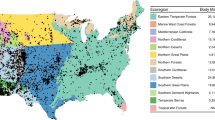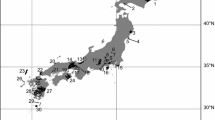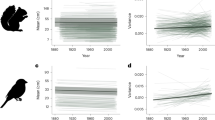Abstract
The tendency of mammals to increase or decrease body size with respect to geography or time depends on the abundance, availability, and size of resources. This dependency accounts for a change in mass with respect to geography, including latitude (Bergmann’s rule), a desert existence, and life on oceanic islands (the island rule), as well as in a seasonal anticipation of winter (Dehnel’s phenomenon) and a tendency for some lineages to increase in mass through time (Cope’s rule). Such a generalized pattern could be called the “resource rule,” reflecting the controlling effect of resource availability on body mass and energy expenditure. The correlation of mammalian size with geography and time reflects the impact of temperature, rainfall, and season on primary production, as well as the necessity in the case of some species to share resources with competitors. The inability of the constituent “rules” to account for all size trends often results from unique patterns of resource availability.


Similar content being viewed by others
References
Ackerman BB, Lindzey FG, Hemker TP (1984) Cougar food habits in southern Utah. J Wildl Manag 48:147–155
Aitchison CW (1987) Review of winter trophic relations of soricine shrews. Mamm Rev 17:1–24
Alder GH, Levins R (1994) The island syndrome in rodent populations. Q Rev Biol 69:473–490
Alroy J (1998) Cope’s rule and the dynamics of body mass evolution in North American fossil mammals. Science 280:731–734
Ashton KG, Tracy MC, de Queiroz A (2000) Is Bergmann’s rule valid for mammals? Am Nat 156:390–415
Auffenberg W (1981) The behavioral ecology of the Komodo monitor. University Press of Florida, Gainesville
Bergmann C (1847) Ueber die Verhältnisse der Wärmeökonomie der Tiere zu ihrer Grösse. Gött Stud 3:595–708
Blackburn TM, Hawkins BA (2004) Bergmann’s rule and the mammal fauna of northern North America. Ecography 27:715–724
Blackburn TM, Ruggiero A (2001) Latitude, elevation and body mass variation in Andean passerine birds. Glob Ecol Biogeogr 10:245–259
Bradley WG, Miller JS, Yousef MK (1974) Thermoregulatory patterns in pocket gophers: desert and mountain. Physiol Zool 47:172–179
Brisbin ILJ, Geiger RA, Graves HB, Pinder JE III, Sweeney JM, Sweeney JR (1977) Morphological characterizations of 2 populations of feral swine. Acta Theriol 22:75–85
Brown JH, Sibly RM (2006) Life-history evolution under a production constraint. Proc Nat Acad Sci USA 103:17595–17599
Brown JH, Marquet PA, Taper ML (1993) Evolution of body size: consequences of an energetic definition of fitness. Am Nat 142:573–584
Butler RJ, Goswami A (2008) Body size evolution in Mesozoic birds: little evidence for Cope’s rule. J Evol Biol 21:1673–1682
Churchfield S, Nesterenko VA, Sharts EA (1999) Food niche overlap and ecological separation amongst six species of coexisting forest shrews (Insectivora: Soricidae) in the Russian Far East. J Zool Lond 248:349–359
Clauset A, Schwab DJ, Redner S (2009) How many species have a mass M? Am Nat 173:256–263
Cope ED (ed) (1887) The origin of the fittest. Appleton, New York
Cope ED (ed) (1896) The primary factors of organic evolution. Open Court, New York
de Queiroz A, Ashton KG (2004) The phylogeny of a species-level tendency: species heritability and deep origins of Bergmann’s rule in tetrapods. Evolution 58:1674–1684
Dehnel A (1949) Studies on the genus Sorex L. Ann Univ Mariae Curie Sklodowska Section C Biol 4:17–102
Diniz-Filho JAF, Bini LM, Rodríguez MA, Rangel TFLVB, Hawkins BA (2007) Seeing the forest for the trees: partitioning ecological and phylogenetic components of Bergmann’s rule in European Carnivora. Ecography 30:598–608
Dunbrack RL, Ramsay MA (1993) The allometry of mammalian adaptations to seasonal environments: a critique of the fasting endurance hypothesis. Oikos 66:336–342
Erlinge S (1987) Why do European stoats Mustela erminea not follow Bergmann’s rule? Holarctic Ecol 10:33–39
Foster JB (1964) Evolution of mammals on islands. Nature 202:234–235
Freckleton RP, Harvey PH, Pagel M (2003) Bergmann’s rule and body size in mammals. Am Nat 161:821–825
Ganzhorn JU, Malcomber S, Andrianantoanina O, Goodman SM (1997) Habitat characteristics and lemur species richness in Madagascar. Biotropica 29:331–343
Geist V (1987) Bergmann’s rule is invalid. Can J Zool 65:1035–1038
Golightly RT Jr, Ohmart RD (1983) Metabolism and body temperature of two desert canids: coyotes and kit foxes. J Mammal 64:624–635
Goltsman M, Kruchenkova EP, Sergeev S, Macdonald DW (2005) “Island syndrome” in a population of Arctic foxes (Alopex lagopus) from Mednyi Island. J Zool Lond 267:405–418
Gould SJ (1997) Cope’s rule as psychological artefact. Nature 385:199–200
Grant PR (1972) Convergent and divergent character displacement. Biol J Linn Soc 4:39–68
Guthrie RD (1984) Mosaics, allelochemics and nutrients. An ecological theory of late Pleistocene megafaunal extinctions. In: Martin PS, Klein S (eds) Quartenary extinctions. University of Arizona Press, Tucson, pp 254–298
Hanski I, Kaikusalo A (1989) Distribution and habitat selection of shrews in Finland. Ann Zool Fenn 26:339–348
Heaney LR (1978) Island area and body size of insular mammals: evidence from the tri-colored squirrel (Callosciurus prevosti) of Southeast Asia. Evolution 32:29–44
Hilderbrand GV, Schwartz CC, Robbins CT, Jacoby ME, Hanley TA, Arthur SM, Servheen C (1999) The importance of meat, particularly salmon, to body size, population productivity and conservation of North American brown bears. Can J Zool 77:132–138
Huston MA, Wolverton S (2009) The global distribution of net primary productivity: resolving the paradox. Ecol Monogr 79:343–377
Iriarte JA, Franklin WL, Johnston WE, Redford KH (1990) Biogeographic variation of food habits and body size of the American puma. Oecologia 85:185–190
James FC (1970) Geographic size variation in birds and its relationship to climate. Ecology 51:365–389
Jessop TS, Madsen T, Summer J, Rudiharto H, Philips JA, Ciofi C (2006) Maximum body size among insular Komodo dragon populations covaries with large prey density. Oikos 112:422–429
Kay RF, Madden RH, Van Schaik C, Higdon D (1997) Primate species richness is determined by plant productivity: implications for conservation. Proc Nat Acad Sci USA 94:13023–13027
Kendeigh SC (1969) Tolerance of cold and Bergmann’s rule. Auk 86:13–25
Kingsolver JG, Pfennig DW (2004) Individual level selection as a cause of Cope’s rule of phyletic increase. Evolution 58:1608–1612
Kleiber M (1932) Body size and metabolism. Hilgardia 6:315–353
Köhler M, Moyà-Solà S (2004) Reduction of brain and sense organs in the fossil insular bovid Myotragus. Brain Behav Evol 63:125–140
Köhler M, Moyà-Solà S (2009) Slow life history and physiological plasticity: survival strategies of a large mammal in a resource-poor environment. Proc Nat Acad Sci USA 106:20354–20358
Kojola I, Laitala H-M (2001) Body size variation of brown bear in Finland. Ann Zool Fenn 38:173–178
Kolb HH (1978) Variation in the size of foxes in Scotland. Biol J Linn Soc 10:291–304
Lahann P, Schmid J, Ganzhorn JL (2006) Geographical variations in populations of Microcebus murinus in Madagascar: resource seasonality or Bergmann’s rule? Intl J Primatol 27:983–999
Langvatn R, Albon SD (1986) Geographic clines in body weight of Norwegian red deer: a novel explanation of Bergmann’s rule? Holarctic Ecol 9:285–293
Laudré JW, Hernández L (2003) Total energy budget and prey requirements of free-ranging coyotes in the Great Basin of western United States. J Arid Environ 55:675–689
Lehman SM, Mayor M, Wright PC (2005) Ecogeographic size variations in sifakas: a test of the resource seasonality and resource quality hypothesis. Am J Phys Anthrop 126:318–328
Lindsey CC (1966) Body sizes of poikilothermic vertebrates at different latitudes. Evolution 20:456–465
Lindstedt SL, Boyce MS (1985) Seasonality, fasting endurance, and body size in mammals. Am Nat 125:873–878
Lister AM (1989) Rapid dwarfing of red deer on Jersey in the Last Interglacial. Nature 342:342–539
Lister AM (1993) Mammoths in miniature. Nature 362:288–289
Lomolino MV (1985) Body size of mammals on islands: the island rule re-examined. Am Nat 125:310–316
Lomolino MV (2005) Body size evolution in insular vertebrates: generality of the island rule. J Biogeogr 32:1683–1699
MacFadden BJ (1986) Fossil horses from “Eohippus” (Hyracotherium) to Equus: scaling, Cope’s Law, and the evolution of body size. Paleobiology 12:355–369
Maehr DS, Belden RC, Land ED, Wilkins L (1990) Food habits of panthers in southwest Florida. J Wildl Manag 54:420–423
Mayr E (1956) Geographic character gradients and climate adaptation. Evolution 10:105–108
McEwan EH (1970) Energy metabolism of barren ground caribou (Rangifer tarandus). Can J Zool 48:391–392
McNab BK (1971) On the ecological significance of Bergmann’s rule. Ecology 52:845–854
McNab BK (1978) Energetics of arboreal folivores: physiological problems and ecological consequences of feeding on an ubiquitous food supply. In: Montgomery GG (ed) The ecology of arboreal folivores. Smithsonian Institute Press, Washington, pp 153–162
McNab BK (1983) Energetics, body size, and the limits to endothermy. J Zool Lond 199:1–29
McNab BK (1994) Resource use and the occurrence of land and freshwater vertebrates on oceanic islands. Am Nat 144:643–660
McNab BK (1999) On the comparative ecological and evolutionary significance of total and mass-specific rates of metabolism. Physiol Biochem Zool 72:642–644
McNab BK (2000a) The influence of body mass, climate, and distribution on the energetics of South Pacific pigeons. Comp Biochem Physiol A 127:309–329
McNab BK (2000b) The standard energetics of mammalian carnivores: Felidae and Hyaenidae. Can J Zool 78:2227–2239
McNab BK (2002) Minimizing energy expenditure facilitates vertebrate persistence on oceanic islands. Ecol Let 5:693–704
McNab BK (2005) Ecological factors influence energetics in the Order Carnivora. Acta Zool Sinica 51:535–545
McNab BK (2008a) An analysis of the factors that influence the level and scaling of mammalian BMR. Comp Biochem Physiol A 151:5–28
McNab BK (2008b) Energy expenditure cannot be effectively analyzed with phylogenetically-based techniques. In: Morris S, Vosloo A (eds) 4th CPB Meeting in Africa: MARA 2008. Molecules to migrations: the pressures of life. Medimond International Proceedings, Bologna, pp 621–625
McNab BK (2009) Resources and energetics determined dinosaur maximal size. Proc Nat Acad Sci USA 106:12184–12188
McNab BK, Morrison PR (1963) Body temperature and metabolism of subspecies of Peromyscus from arid and mesic environments. Ecol Monogr 33:63–82
Medina AI, Dardo A, Martí DA, Bidau CJ (2007) Subterranean rodents of the genus Ctenomys (Caviomorpha, Ctenomyidae) follow the converse to Bergmann’s rule. J Biogeogr 34:1439–1454
Meiri S, Dayan T (2003) On the validity of Bergmann’s rule. J Biogeogr 30:331–351
Meiri S, Dayan T, Simberloff D (2004) Carnivores, biases and Bergmann’s rule. Biol J Linn Soc 81:579–588
Meiri S, Yom-Tov Y, Geffen E (2007) What determines conformity to Bergmann’s rule? Global Ecol Biogeogr 16:788–794
Meiri S, Cooper N, Purvis A (2008a) This island rule: made to be broken? Proc R Soc B 245:141–148
Meiri S, Meijaard E, Wich SA, Groves CP, Helgen KM (2008b) Mammals of Borneo—small size on a large island. J Biogeogr 35:1087–1094
Merritt JF, Zegers DA (2002) Maximizing survivorship in cold: thermogenic profiles of non-hibernating mammals. Acta Theriol 47:221–234
Mezhzhderin VA (1964) Dehnel’s phenomenon and its possible explanation. Acta Theriol 8:95–114
Miller JS, Hickling GJ (1990) Fasting endurance and the evolution of mammalian body size. Funct Ecol 4:5–12
Mousseau TA (1997) Ectotherms follow the converse to Bergmann’s rule. Evolution 51:630–632
Mueller P, Diamond J (2001) Metabolic rate and environmental productivity: well-provisioned animals evolved to run and idle fast. Proc Natl Acad Sci USA 98:12550–12554
Nilssen KJ, Maathiesen SD, Blix AS (1994) Metabolic rate and plasma T3 in ad. lib. fed and starved muskoxen. Rangifer 14:79–81
Ochocin’ska D, Taylor JRE (2003) Bergmann’s rule in shrews: geographical variation of body size in Palearctic Sorex species. Biol J Linn Soc 78:365–381
Partridge L, Coyne JA (1997) Bergmann’s rule in ectotherms: is it adaptive? Evolution 51:632–635
Raia P, Meiri S (2006) The island rule in large mammals: paleontology meets ecology. Evolution 60:1731–1742
Raia P, Barbera C, Conte M (2003) The fast life of a dwarfed giant. Evol Ecol 17:293–312
Ralls K, Harvey PH (1985) Geographic variation in size and sexual dimorphism of North American weasels. Biol J Linn Soc 25:119–167
Rasmussen GSA, Gusset M, Courchamp F, Macdonald DW (2008) Achilles’ heel of sociality revealed by energetic poverty trap in cursorial hunters. Am Nat 172:508–518
Ray C (1960) The application of Bergmann’s and Allen’s rules to the poikilotherms. J Morphol 106:85–108
Robinette WL, Gashwiler JS, Morris OW (1959) Food habits of the cougar in Utah and Nevada. J Wildl Manag 23:261–273
Rodríguez MA, López-Sañudo IL, Hawkins BA (2006) The geographic distribution of mammal body size in Europe. Glob Ecol Biogeogr 15:173–181
Rodríguez MA, Olalla-Tárraga MA, Hawkins BA (2008) Bergmann’s rule and the geography of mammal body size in the Western Hemisphere. Glob Ecol Biogeogr 17:274–283
Roemer GW, Smith DA, Garcelon DK, Wayne RK (2001) The behavioural ecology of the island fox (Urocyon littoralis). J Zool Lond 255:1–14
Rosenzweig ML (1968a) Net primary productivity of terrestrial communities: prediction from climatological data. Am Nat 102:67–74
Rosenzweig ML (1968b) The strategy of body size in mammalian carnivores. Am Midl Nat 80:299–315
Roth VL (1990) Insular dwarf elephants: a case study in body mass estimation and ecological inference. In: Damuth J, McFadden BJ (eds) Body size in mammalian paleontology. Cambridge University Press, Cambridge, pp 151–179
Roth VL (1992) Inferences from allometry and fossils: dwarfing of elephants on islands. Oxf Surv Evol Biol 8:259–288
Schaller JB, Crawshaw PG Jr (1980) Movement patterns of jaguar. Biotropica 12:161–168
Schmidt NM, Jensen PM (2003) Changes in mammalian body length over 175 years—adaptations to fragmented to landscape? Conserv Ecol 7:6
Schmidt NM, Jensen PM (2005) Concomitant patterns in avian and mammalian body length changes in Denmark. Ecol Soc 10:5
Scholander PF (1955) Evolution of climatic adaptation in homeotherms. Evolution 9:15–26
Simms DA (1979) North American weasels: resource utilization and distribution. Can J Zool 57:504–520
Sondaar PY (1977) Insularity and its effect on mammal evolution. In: Hecht MK, Goody PC, Hecht BM (eds) Major patterns in vertebrate evolution. Plenum, New York, pp 671–707
Spalding DJ, Lesowski J (1971) Winter food of the cougar in south-central British Columbia. J Wildl Manag 35:378–381
Stanley SM (1973) An explanation for Cope’s rule. Evolution 27:1–26
Stuenes S (1989) Taxonomy, habits, and relationships of the subfossil Madagascaran hippopotami Hippopotamus lemerlei and H. madagascarensis. J Vertebr Paleontol 9:241–268
Swenson JE, Adamic M, Huber D, Stokke S (2007) Brown bear body mass and growth in northern and southern Europe. Oecologia 153:37–47
Taylor JM, Smith SC, Calaby JH (1985) Altitudinal distribution and body size among New Guinean Rattus (Rodentia: Muridae). J Mammal 66:353–358
Toweill DE, Meslow EC (1977) Food habits of cougars in Oregon. J Wildl Manag 41:376–378
Van Valen L (1973) Pattern and the balance of nature. Evol Theory 1:31–49
Van Valkenburgh B (1991) Iterative evolution of hypercarnivory in canids (Mammalia: Carnivora): evolutionary interactions among sympatric predators. Paleobiology 17:340–362
Van Valkenburgh B, Wang X, Damuth J (2004) Cope’s rule, hypercarnivory, and extinction in North American canids. Science 306:101–104
Van Vuren DH, Bakker VJ (2008) Rapid morphological change in an insular population of feral sheep. J Zool Lond 277:221–231
Vartanyan SI, Garutt VE, Sher AV (1993) Holocene dwarf mammoths from Wrangel Island in the Siberian Arctic. Nature 362:337–340
Webster AJ, Gittleman JL, Purvis A (2004) The life history legacy of evolutionary body size change in carnivores. J Evol Biol 17:396–407
White TA, Searle JB (2007) Factors explaining increased body size in common shrews (Sorex araneus) on Scottish Islands. J Biogeogr 34:356–363
White CR, Seymour RS (2003) Mammalian basal metabolic rate is proportional to body mass2/3. Proc Natl Acad Sci USA 100:4046–4049
Wikelski M, Thom C (2000) Marine iguanas shrink to survive El Niño. Nature 403:37–38
Wong ST, Servheen C, Ambu L, Norhayat A (2005) Impacts of fruit production cycles on Malayan sun bears and bearded pigs in lowland tropical forest of Sabah Malaysian Borneo. J Trop Ecol 21:627–639
Wyatt JR, Eltringham SK (1974) The daily activity of the elephant in the Rwenzori National Park. East Afr Wildl J 12:273–289
Yáñez JL, Cárdenas JC, Gezelle P, Jaksic FM (1986) Food habits of the southernmost mountain lions (Felis concolor) in South America: natural versus livestocked ranges. J Mammal 67:604–606
Yom-Tov Y, Geffen E (2006) Geographic variation in body size: the effects of ambient temperature and precipitation. Oecologia 148:213–218
Yom-Tov Y, Nix H (1986) Climatological correlates for body size of five species of Australian mammals. Biol J Linn Soc 29:245–262
Yom-Tov Y, Yom-Tov J (2005) Global warming, Bergmann’s rule and body size in the masked shrew Sorex cinereus Kerr in Alaska. J Anim Ecol 74:803–808
Author information
Authors and Affiliations
Corresponding author
Additional information
Communicated by Jörg Ganzhorn.
Rights and permissions
About this article
Cite this article
McNab, B.K. Geographic and temporal correlations of mammalian size reconsidered: a resource rule. Oecologia 164, 13–23 (2010). https://doi.org/10.1007/s00442-010-1621-5
Received:
Accepted:
Published:
Issue Date:
DOI: https://doi.org/10.1007/s00442-010-1621-5




